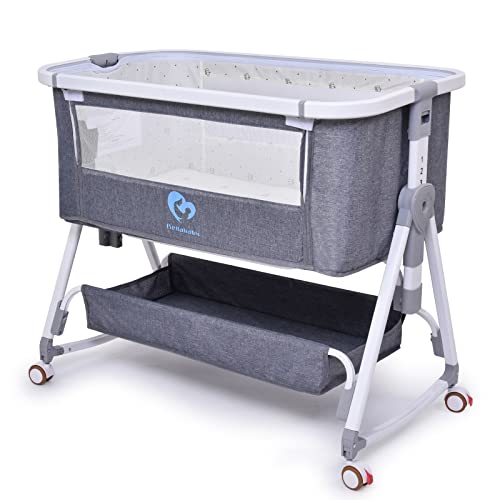The Ultimate Guide to Choosing a Bedside Bassinet: Safety, Comfort, and Convenience
Intro
As new parents step into the exciting yet overwhelming world of childcare, one necessary item that typically tops the list is a bedside bassinet. These spaces function as a safe sleeping location for newborns while permitting parents to preserve close proximity throughout the night. With a myriad of options available on the market today, understanding the functions, advantages, and considerations for a bedside bassinet can make a significant difference in the total parenting experience.
This post will check out the various types of bedside bassinets, safety requirements, essential functions to think about, and some frequently asked questions to help you make a notified decision.
What is a Bedside Bassinet?
A bedside bassinet is a sleeping space designed for newborns and infants, generally used for the first few months of a baby's life. my homepage is generally smaller sized than a crib and provides the benefit of being positioned beside an adult bed, enabling parents to tend to their babies quickly throughout nighttime.
Types of Bedside Bassinets
There are a number of types of bedside bassinets offered, each created with distinct functions and advantages:
- Co-Sleeping Bassinets: These are designed to attach firmly to the side of the moms and dad's bed, enabling easy access throughout nighttime feedings and comforting without fully co-sleeping.
- Standalone Bassinets: These are free-standing variations that sit beside your bed but do not attach. While they take up more space, they can sometimes provide a larger sleeping area.
- Travel Bassinets: Lightweight and portable, these bassinets are developed for families on the go. They can be folded or taken apart quickly, offering benefit while taking a trip.
- Convertible Bassinets: Some models can change into cribs or playards, extending their lifespan and making them a more cost-effective option.
Benefits of Using a Bedside Bassinet
Selecting a bedside bassinet can provide various benefits, consisting of:
- Convenience: Parents can easily access their baby during the night for feeding, soothing, or diaper modifications without rising.
- Security: Bassinets are created particularly for infants, typically sticking to security standards that help in reducing the danger of Sudden Infant Death Syndrome (SIDS).
- Comfort: Babies can feel secured with their parents nearby, promoting a sense of safety that is favorable to much better sleep.
- Space-saving: Bedside bassinets are usually compact and easy to suit smaller sized bedrooms.
Secret Safety Features to Consider
When selecting a bedside bassinet, ensuring safety is critical. Here are a couple of vital safety features to think about:
- Stable Base: Ensure the bassinet has a tough structure that can not topple quickly. Check that wheels lock into place to avoid movement.
- Breathable Fabrics: Look for products that allow air blood circulation to minimize the danger of suffocation.
- Height Adjustability: A bassinette that gets used to the height of your bed can enhance security and convenience.
- No Drop Sides: Select designs that do not have drop sides, as they can position a danger of the baby falling out or getting trapped.
- Certification: Always ensure that the bassinet complies with safety requirements set by recognized agencies like the American Academy of Pediatrics (AAP).
Extra Features to Look For
Aside from safety, here are some extra functions to think about when looking for the right bedside bassinet:
- Storage Space: Some bassinets feature built-in storage for essentials like diapers, wipes, and attire.
- Rocking or Gliding Mechanism: This can assist relieve babies who have trouble settling to sleep.
- Sound and Light Features: Some designs consist of calming sounds, nightlights, or projections that can assist soothe infants to sleep.
- Washable Components: Make sure detachable covers and sheets are maker washable for easy cleaning.
Selecting the ideal bedside bassinet is an important choice that can exceptionally affect the early parenting experience. By comprehending the various types offered, their benefits, essential security features, and additional conveniences, parents can make an informed choice to guarantee both their baby's convenience and security.
Eventually, the right bedside bassinet need to accommodate individual family needs while enhancing the bond between parents and their newborns during those valuable first couple of months.
Frequently Asked Questions about Bedside Bassinets
1. For how long can Info use a bedside bassinet for my baby?
A lot of bassinets are designed for infants approximately about 4 to 6 months, or till the baby can roll over, pull up, or go beyond the weight limit specified by the producer (typically around 20-30 pounds).
2. Baby Bedside Sleeper for co-sleeping?
While bedside bassinets offer close proximity, it's vital to ensure they're securely attached to the bed. Always follow standards for safe sleeping to lower the threat of SIDS.
3. Can I use a bedside bassinet for a premature baby?
Yes, many bedside bassinets can accommodate premature infants. However, it's important to consult with a pediatrician for suggestions based on your baby's specific needs.
4. What should I look for in regards to mattress security in a bedside bassinet?
Make certain that the bed mattress fits securely versus the sides of the bassinet without any gaps. The mattress needs to be firm and covered with a fitted sheet to lower the threat of suffocation.
5. Are there any particular cleaning directions I should follow?
Many bassinets have removable covers that can be cleaned. Always follow the producer's instructions for cleansing and maintaining the bassinet.
By attending to these concerns, parents can navigate the decision-making procedure concerning bedside bassinets more successfully, ensuring security and convenience as they invite their youngster into the world.

